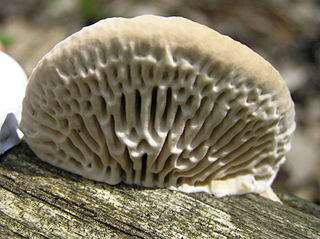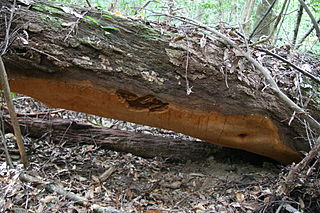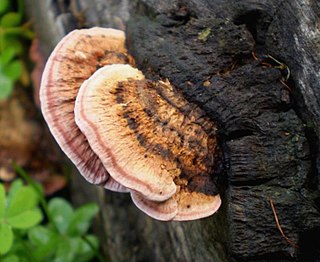Related Research Articles

The Polyporales are an order of about 1800 species of fungi in the division Basidiomycota. The order includes some polypores as well as many corticioid fungi and a few agarics. Many species within the order are saprotrophic, most of them wood-rotters. Some genera, such as Ganoderma and Fomes, contain species that attack living tissues and then continue to degrade the wood of their dead hosts. Those of economic importance include several important pathogens of forest and amenity trees and a few species that cause damage by rotting structural timber. Some of the Polyporales are commercially cultivated and marketed for use as food items or in traditional Chinese medicine.

Fomitopsis betulina, commonly known as the birch polypore, birch bracket, or razor strop, is a common bracket fungus and, as the name suggests, grows almost exclusively on birch trees. The brackets burst out from the bark of the tree, and these fruit bodies can last for more than a year.

The Polyporaceae are a family of poroid fungi belonging to the Basidiomycota. The flesh of their fruit bodies varies from soft to very tough. Most members of this family have their hymenium in vertical pores on the underside of the caps, but some of them have gills or gill-like structures. Many species are brackets, but others have a definite stipe – for example, Polyporus badius.
Abundisporus is a small genus of poroid fungi currently with seven recognized species. They differ from other polypores in having coloured rather than hyaline spores.

The Fomitopsidaceae are a family of fungi in the order Polyporales. Most species are parasitic on woody plants, and tend to cause brown rots. The name comes from Fomitopsis + -aceae.

Buglossoporus is a genus of fungi in the family Fomitopsidaceae. The genus was circumscribed in 1966 by Czech mycologists František Kotlába and Zdeněk Pouzar, with Buglossoporus quercinus as the type species. In some works, Buglossoporus has been treated as a synonym of Piptoporus.

Daedalea is a genus of fungi in the family Fomitopsidaceae. The genus was circumscribed in 1801 by mycologist Christian Hendrik Persoon, based on the type D. quercina and four other species. The generic name is derived from the Ancient Greek δαιδαλεος.

Fomitopsis is a genus of more than 40 species of bracket fungi in the family Fomitopsidaceae.

Haploporus is a genus of poroid fungi in the family Polyporaceae.

Favolus, or honeycomb fungus, is a genus of fungi in the family Polyporaceae. The fruit bodies of Favolus species are fleshy with radially arranged pores on the underside of the cap that are angular and deeply pitted, somewhat resembling a honeycomb.

Skeletocutis is a genus of about 40 species of poroid fungi in the family Polyporaceae. The genus has a cosmopolitan distribution, although most species are found in the Northern Hemisphere. It causes a white rot in a diverse array of woody substrates, and the fruit bodies grow as a crust on the surface of the decaying wood. Sometimes the edges of the crust are turned outward to form rudimentary bracket-like caps.

Phellinus ellipsoideus is a species of polypore fungus in the family Hymenochaetaceae, a specimen of which produced the largest fungal fruit body ever recorded. Found in China, the fruit bodies produced by the species are brown, woody basidiocarps that grow on dead wood, where the fungus feeds as a saprotroph. The basidiocarps are perennial, allowing them to grow very large under favourable circumstances. They are resupinate, measuring 30 centimetres (12 in) or more in length, though typically extending less than a centimetre from the surface of the wood. P. ellipsoideus produces distinct ellipsoidal spores, after which it is named, and unusual setae. These two features allow it to be readily differentiated microscopically from other, similar species. Chemical compounds isolated from the species include several steroidal compounds. These may have pharmacological applications, but further research is needed.

Rhodofomitopsis lilacinogilva is a species of bracket fungus in the family Fomitopsidaceae. Known primarily from Australia, it has also been recorded from Brazil and India. It is a white-rot fungus that grows on rotting eucalyptus wood. Its main identifying feature is the lilac colour of the pore surface on the underside of the fruit body.

Fibroporia is a genus of ten species of poroid crust fungi in the family Fomitopsidaceae. The genus contains species similar to those in genus Antrodia, but they are phylogenetically distinct.

Rhodofomitopsis is a genus of four species of poroid fungi in the family Fomitopsidaceae. It was circumscribed by Chinese mycologists in 2016, with Rhodofomitopsis feei as the type species. Rhodofomitopsis is a distinct lineage of fungi that were previously placed in genus Fomitopsis. The generic name alludes to this resemblance to Fomitopsis and the violaceous pore surface.
Fragiliporia is the sole genus in the fungus family Fragiliporiaceae. It contains the poroid crust fungus Fragiliporia fragilis, described as new to science by Chinese mycologists in 2014. The type specimen of this fungus was discovered growing on a rotting stump of alder in the Gaoligongshan National Nature Reserve in Yunnan. The specific epithet fragilis refers to the brittle fruit bodies of the fungus. Molecular phylogenetics shows that the fungus is in an isolated position in the Polyporales, distinct from the six previously identified clades in this order. In a later study (2017), Fragiliporia was recovered in a phylogenetically isolated position as sister to Candelabrochaete africana.
Buglossoporus eucalypticola is a species of poroid fungus in the family Fomitopsidaceae. It was described as a new species in 2016 by mycologists Mei-Ling Han, Bao-Kai Cui, and Yu-Cheng Dai. The type specimen was collected in the Danzhou Tropical Botanical Garden, in Danzhou, China. It was growing on a dead Eucalyptus tree. The fruit body has a fan-shaped or semicircular cap that projects up to 10 cm (3.9 in), 6.5 cm (2.6 in) wide, and 7 mm (0.3 in) thick at its base. The surface colour when fresh is peach to brownish orange, but when dry becomes clay-pink to cinnamon. The pore surface on the cap underside is initially white before becoming pinkish buff or clay-buff to dark brown. B. eucalypticola causes a brown rot in its host.
Fomitopsis subfeei is a species of polypore fungus in the family Fomitopsidaceae. Found in southern China, it was reported as new to science in 2014 by mycologists Mei-Ling Han and Bao-Kai Cui. Characteristics of the fungus include perennial, effused-reflexed to pileate fruit bodies, a concentrically grooved cap surface, and a pinkish-brown to vinaceous-brown pore surface on the cap underside. Microscopic characters include spindle-shaped cystidioles, and small, oblong-ellipsoid spores measuring 4–5 by 1.9–2.5 μm. The fungus causes a brown rot on gymnosperms.
Neolentiporus is a fungal genus in the family Fomitopsidaceae. It contains Neolentiporus squamosellus and the type species N. maculatissimus. The genus was circumscribed by mycologist Mario Rajchenberg in 1995.
Cerarioporia is a fungal genus in the family Polyporaceae. It is a monotypic genus, containing the single species Cerarioporia cystidiata, a wood-decaying poroid crust fungus found in tropical China. Cerarioporia resembles fungi placed in the genus Antrodia, but can be distinguished by its waxy to resinous fruit bodies, and microscopically by the thick-walled, encrusted cystidia. Additionally, Cerarioporia causes a white rot, while Antrodia are brown-rot fungi.
References
- 1 2 3 Han, Mei-Ling; Chen, Yuan-Yuan; Shen, Lu-Lu; Song, Jie; Vlasák, Josef; Dai, Yu-Cheng; Cui, Bao-Kai (2016). "Taxonomy and phylogeny of the brown-rot fungi: Fomitopsis and its related genera". Fungal Diversity. 80 (1): 343–373. doi:10.1007/s13225-016-0364-y.

- ↑ Justo, Alfredo; Miettinen, Otto; Floudas, Dimitrios; Ortiz-Santana, Beatriz; Sjökvist, Elisabet; Lindner, Daniel; Nakasone, Karen; Niemelä, Tuomo; Larsson, Karl-Henrik; Ryvarden, Leif; Hibbett, David S. (2017). "A revised family-level classification of the Polyporales (Basidiomycota)". Fungal Biology. 121 (9): 798–824. doi:10.1016/j.funbio.2017.05.010. PMID 28800851.
- 1 2 Han ML; Cui BK. (2014). "Morphology and molecular phylogeny for two new species of Fomitopsis (Basidiomycota) from South China". Mycological Progress. 13 (3): 905–914. doi:10.1007/s11557-014-0976-0.